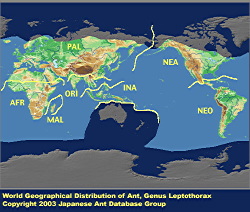
|
genus
|
Leptothorax
|
 |

|
|
Japanese Name
|
Muneboso-ari-zoku
|
Original Reference
|
|
Mayr, G. (1855) Formicina austriaca. Beschreibung der bisher im sterreichischen Kaiserstaate aufgefundenen Ameisen nebst Hinzufgung jener in Deutschland, in der Schweiz und in Italien vorkommenden Ameisen. Verhandlungen des Zoologisch-Botanischen Vereins in Wien 5: 273- 478.
|
Description
|
|
Small, monomorphic myrmicine ants. Mandibles usually each with 5 teeth (6 in some species); apical tooth largest; basal smallest. Palpal formula 5:3. Median area of clypeus broad, extending between the frontal lobes. Anterior margin of clypeus varying in shape, from weakly convex to strongly produced medially. Frontal carinae short. Antennae 11- or 12-segmented; apical 3 segments forming a club. Eyes medium to large in size, situated at the midlength or slightly forwards on sides of head. Anterolateral corners of pronotum round to angulate in dorsal view. Metanotal groove varying from deeply impressed to obscure or absent. Propodeum with posterodorsal spines or teeth (these rarely lacking). Body hairs usually short, stout and erect, sometimes long or lacking.
|
|

|
Remarks
|
|
Leptothorax resembles Tetramorium Mayr, but it is distinguished by the following characters (Bolton, 1982): (1) Maxillary palpi 5-segmented (3 or 4 segmented in Tetramorium); (2) clypeus without carinae in front of antennal insertions (such carinae are present in Tetramorium); (3) mandibles generally with 5 teeth, rarely 6; the apical tooth largest and the others gradually smaller towards the base (seven teeth are usually present in Tetramorium, with the apical 3 largest). Leptothorax is a relatively large genus, comprising about 310 described species, distributed world-wide except for the Australian region. Most species are Palaerctic or Nearctic. The Palaerctic fauna excluding that of Western Europe has not been taxonomically revised. The genus includes a number of socially parasitic or slave-making species (Alloway, 1980). Five named species were listed in Myrmecological Society of Japan Editorial Committee (1988). Terayama & Satoh (1990) have subsequently raised L. congruus var. spinosior to full species rank. Recently Terayama & Onoyama (1999) described 10 new species. Currently 15 species are reported from Japan.
|
References
|
|
- Bolton, B. (1982). Afrotropical species of the myrmicine ant genera Cardiocondyla, Leptothorax, Melissotarsus, Messor and Cataulacus (Formicidae). . Bull. Br. Mus. Nat. Hist. (Ent.), 45, 307-370.
- Alloway, T. M. (1980). Origins of slavery in leptothoracine ants. Am. Nat., 115, 247-261.
- Myrmecological Society of Japan, Editorial Committee (ed.) (Ed.). (1988). A list of the ants of Japan with common Japanese names. The Myrmecological Society of Japan, Tokyo.
- Terayama, M. & T. Satoh (1990b. ). Taxonomic notes on two Japanese species of Formicidae (Hymenoptera). . Jpn. J. Ent., 58, 532.
- Formicina austriaca. Beschreibung der bisher im sterreichischen Kaiserstaate aufgefundenen Ameisen nebst Hinzufgung jener in Deutschland, in der Schweiz und in Italien vorkommenden Ameisen. Verhandlungen des Zoologisch-Botanischen Vereins in Wien 5: 273-478.
- Terayama, M. & K. Onoyama (1999). The ant genus Leptothorax Mayr (Hymenoptera; Formicidae). Memoris of the Myrmecological Society of Japan 1: 71-97.
|
Editor
|
|
Original text by Mamoru Terayama, Keiichi Onoyama, and Masaaki Morisita. English translation by Mamoru Terayama, edited by Robert W. Taylor.
|
|